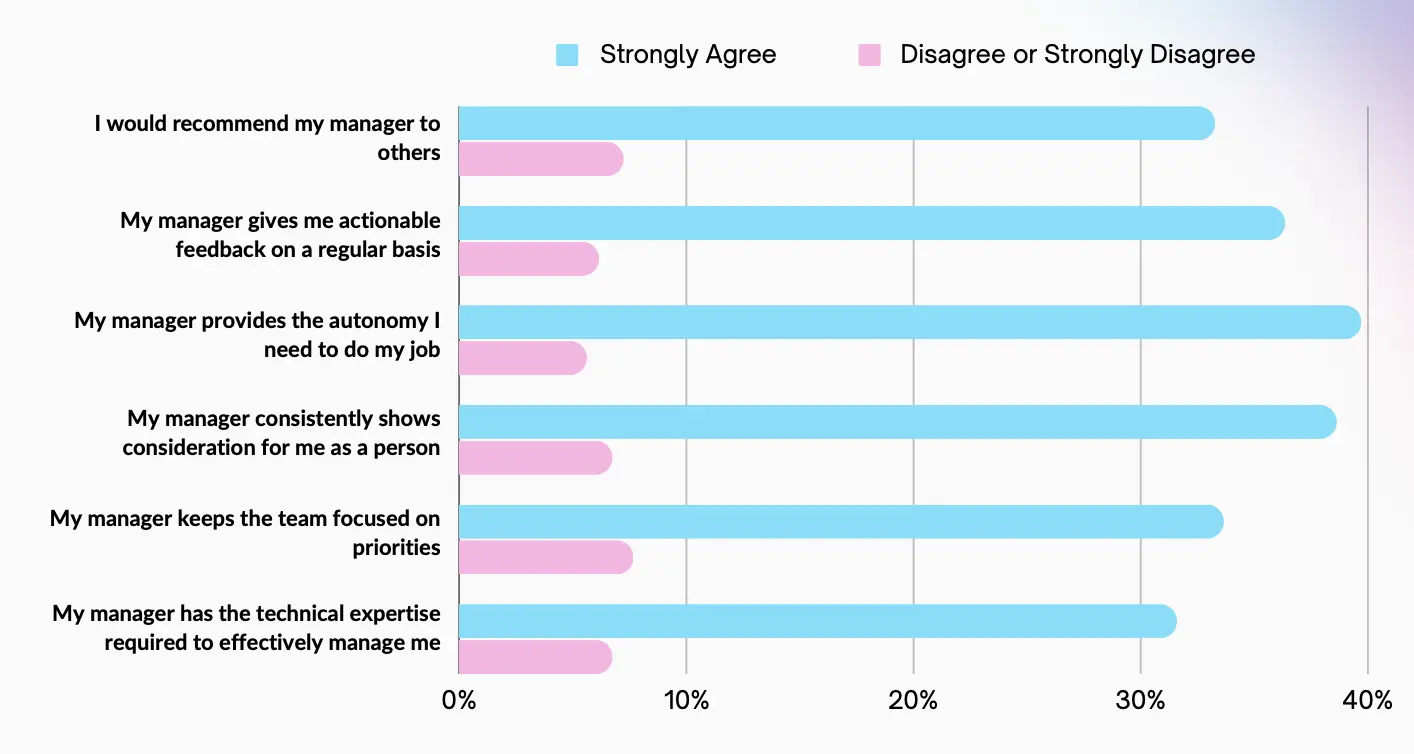Introduction: Navigating the Future of Work
Understanding and shaping organizational health and culture have become pivotal for leaders and HR professionals to create adaptable, resilient, and sustainable businesses. The 'State of Organizational Health & Culture 2024' report by Happily.ai presents invaluable insights and strategic directions. We delve into the report's key findings, providing actionable insights for business and HR leaders aiming to foster thriving workplaces.
The comprehensive diagnostic across various companies in 2024 unveils critical insights into employee engagement, psychological safety, and managerial effectiveness. This summary offers a snapshot of where organizations stand and where they must focus to build high-performing and satisfied teams.
Our goal is to provide a comprehensive and actionable analysis of organizational health, emphasizing employee engagement and cultural dynamics, to guide companies toward a thriving and productive work environment.
The Pillars of Organizational Health
- Psychological Safety:
- Insight: While there's a moderate level of psychological safety across organizations, many employees still hesitate to take risks or suggest ideas.
- Action Point: Strengthening an environment encouraging risk-taking and open communication is essential. Additional effort is required when working in cultures with social norms that work against open communication. Skills must be developed and nurtured around giving and receiving critical feedback.
- Manager Effectiveness:
- Insight: Managerial skills are above average, yet there is room for improvement in feedback delivery, technical expertise, and strategic decision-making.
- Action Point: Invest in leadership development programs focusing on these key areas. Managers should be held accountable for their ability to manage performance, engagement, and retention.
- Culture & Values Alignment:
- Insight: There's a gap between the espoused values of the company and their actual implementation.
- Action Point: Regular workshops and initiatives to align employees with the company's core values are crucial but are just a starting point. Recognition programs must be deployed to actively reinforce and reward actions aligned with company values.
Employee Well-being: A Central Focus
- Insight: The average WHO-5 Index score indicates a need for urgent attention to employee well-being.
- Action Point: Comprehensive well-being programs and regular assessments are vital, and key factors that are negatively impacting well-being (workload imbalance, low autonomy, etc.) should also be taken into consideration.

Employee Satisfaction and eNPS: The Indicators of Engagement
- Insight: The varied eNPS scores across companies reveal employee advocacy and satisfaction differences.
- Action Point: Addressing key satisfaction factors is crucial for converting detractors and passives into promoters. Use feedback to uncover employees' dissatisfaction, then communicate and/or act to acknowledge and resolve concerns.

Transforming Leadership: The Key to Organizational Success
Managers and leaders are pivotal in translating strategy into successful implementation while keeping employees engaged and aligned toward a shared goal and purpose.
- Managerial Development: The report emphasizes the importance of nurturing managerial skills. Leadership training programs that provide actionable feedback, set strategic goals, and enhance decision-making capabilities are imperative.
- Empowering Managers: To excel in the evolving corporate world, managers must have leadership skills and tools for effective team management and employee development.

Building a Culture that Resonates
"Culture eats strategy for breakfast," as stated by Peter Drucker, a renowned business management thinker. A strong culture requires aligning company values with daily operations and decision-making processes.
- Culture & Values: Regular initiatives to reinforce the company's core values and ensure they are reflected in every aspect of the business are key strategies for cultural alignment.
- Leadership's Role in Culture: The actions and decisions of leaders and managers should consistently exemplify the company's values, serving as a model for the rest of the organization.

Elevating Employee Well-being and Satisfaction
Employee well-being and satisfaction are not just HR concerns but business imperatives that directly impact organizational performance.
- Prioritizing Well-being: Implementing comprehensive well-being programs and fostering a work environment that supports mental health is crucial. Proactively and quickly identify toxic behaviors and cultural misfits contributing to declining well-being.
- Enhancing Satisfaction: Understanding and acting on factors influencing employee satisfaction, such as management practices and workplace culture, can lead to a more engaged and productive workforce.
Strategic Recommendations: Charting the Course Forward
Drawing from the comprehensive insights of the 2024 report, here are key strategies for business and HR leaders to enhance organizational health and culture:
- Fostering Psychological Safety: Create a culture where employees feel safe to express ideas and take risks. Emphasize inclusive leadership and open communication as pillars of a supportive work environment.
- Enhancing Managerial Effectiveness: Invest in leadership development programs focusing on feedback delivery, strategic decision-making, and technical expertise. Mentorship programs and continuous learning opportunities can further empower managers.
- Aligning Culture and Values: Regularly integrate company values into operations and decision-making. Leadership should actively model these values, reinforcing their importance through company practices and policies.
- Developing Human Skills: Improve organizational communication, empathy, and problem-solving skills. Training programs, team-building activities, and skills-embedded feedback apps like Happily.ai are effective developmental tools.
- Prioritizing Employee Well-being: Implement comprehensive well-being programs, including mental health support and work-life balance initiatives. Regular assessments can help track progress and adjust strategies as needed.
- Improving Employee Satisfaction (eNPS): Address satisfaction factors identified in the eNPS analysis by focusing on managerial effectiveness and cultural alignment. Engage employees in decision-making processes to foster a sense of ownership and commitment.

Leveraging AI for Organizational Transformation with Happily.ai
Artificial intelligence (AI) is reshaping how we understand and improve workplace dynamics. For example, Happily.ai harnesses the power of AI to revolutionize organizational health and culture, offering a new dimension of insight and strategy for business leaders.
- AI-Driven Insights: Happily.ai analyzes patterns and trends in employee feedback, engagement levels, and overall organizational health. This technology enables leaders to gain a deeper, data-driven understanding of workplace dynamics.
- Actionable Strategies with AI: The platform goes beyond analysis, offering practical, AI-generated recommendations tailored to each organization's unique needs. Whether enhancing communication, boosting morale, or improving managerial effectiveness, Happily.ai provides actionable strategies to drive positive change.
- Continuous Learning and Adaptation: With AI at its core, Happily.ai continuously learns and adapts, ensuring that its insights and strategies remain relevant and effective as organizations evolve.
- Empowering Leaders with Technology: Happily.ai equips leaders with a powerful tool to make informed decisions and implement effective changes, ultimately leading to a more engaged, productive, and satisfied workforce.
Incorporating AI into organizational health and culture significantly advances how companies approach these critical aspects of their business.
Looking Ahead: The Future of Organizational Health
The "State of Organizational Health & Culture 2024" report provides a snapshot of the current landscape and sets the stage for future developments. As business environments continue to evolve, so will the challenges and opportunities in organizational health. Staying adaptive, responsive, and proactive in these areas will be crucial for leaders and organizations seeking to thrive in the dynamic world of work.










